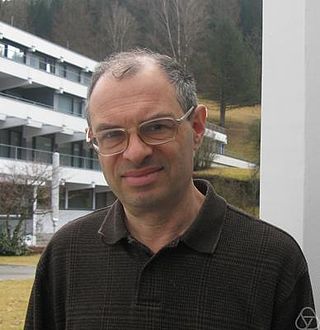Related Research Articles
In mathematics, a symplectomorphism or symplectic map is an isomorphism in the category of symplectic manifolds. In classical mechanics, a symplectomorphism represents a transformation of phase space that is volume-preserving and preserves the symplectic structure of phase space, and is called a canonical transformation.

Geometric group theory is an area in mathematics devoted to the study of finitely generated groups via exploring the connections between algebraic properties of such groups and topological and geometric properties of spaces on which these groups can act non-trivially.

Bertram Kostant was an American mathematician who worked in representation theory, differential geometry, and mathematical physics.

Shou-Wu Zhang is a Chinese-American mathematician known for his work in number theory and arithmetic geometry. He is currently a Professor of Mathematics at Princeton University.
In mathematics, the Weinstein conjecture refers to a general existence problem for periodic orbits of Hamiltonian or Reeb vector flows. More specifically, the conjecture claims that on a compact contact manifold, its Reeb vector field should carry at least one periodic orbit.
Shlomo Zvi Sternberg, is an American mathematician known for his work in geometry, particularly symplectic geometry and Lie theory.

In the mathematical field of knot theory, the hyperbolic volume of a hyperbolic link is the volume of the link's complement with respect to its complete hyperbolic metric. The volume is necessarily a finite real number, and is a topological invariant of the link. As a link invariant, it was first studied by William Thurston in connection with his geometrization conjecture.

Victor Ginzburg is a Russian American mathematician who works in representation theory and in noncommutative geometry. He is known for his contributions to geometric representation theory, especially, for his works on representations of quantum groups and Hecke algebras, and on the geometric Langlands program. He is currently a Professor of Mathematics at the University of Chicago.

Johannes Jisse (Hans) Duistermaat was a Dutch mathematician.

Richard Paul Winsley Thomas is a British mathematician working in several areas of geometry. He is a professor at Imperial College London. He studies moduli problems in algebraic geometry, and ‘mirror symmetry’—a phenomenon in pure mathematics predicted by string theory in theoretical physics.

Eckhard Meinrenken is a German-Canadian mathematician working in differential geometry and mathematical physics. He is a professor at University of Toronto.

Helmut Hermann W. Hofer is a German-American mathematician, one of the founders of the area of symplectic topology.
In differential geometry, algebraic geometry, and gauge theory, the Kobayashi–Hitchin correspondence relates stable vector bundles over a complex manifold to Einstein–Hermitian vector bundles. The correspondence is named after Shoshichi Kobayashi and Nigel Hitchin, who independently conjectured in the 1980s that the moduli spaces of stable vector bundles and Einstein–Hermitian vector bundles over a complex manifold were essentially the same.
Ailana Margaret Fraser is a Canadian mathematician and professor of mathematics at the University of British Columbia. She is known for her work in geometric analysis and the theory of minimal surfaces. Her research is particularly focused on extremal eigenvalue problems and sharp eigenvalue estimates for surfaces, min-max minimal surface theory, free boundary minimal surfaces, and positive isotropic curvature.
Tian Ye or Ye Tian is a Chinese mathematician known for his research in number theory and arithmetic geometry.
This is a glossary of properties and concepts in symplectic geometry in mathematics. The terms listed here cover the occurrences of symplectic geometry both in topology as well as in algebraic geometry. The glossary also includes notions from Hamiltonian geometry, Poisson geometry and geometric quantization.
Mihnea Popa is a Romanian-American mathematician at Harvard University, specializing in algebraic geometry. He is known for his work on complex birational geometry, Hodge theory, abelian varieties, and vector bundles.
Yongbin Ruan is a Chinese mathematician, specializing in algebraic geometry, differential geometry, and symplectic geometry with applications to string theory.
Anton Yurevich Alekseev is a Russian mathematician.
In mathematics, and in particular algebraic geometry, K-stability is an algebro-geometric stability condition for projective algebraic varieties and complex manifolds. K-stability is of particular importance for the case of Fano varieties, where it is the correct stability condition to allow the formation of moduli spaces, and where it precisely characterises the existence of Kähler–Einstein metrics.
References
- Guillemin, V.; Sternberg, S. (1982), "Geometric quantization and multiplicities of group representations", Inventiones Mathematicae , 67 (3): 515–538, Bibcode:1982InMat..67..515G, doi:10.1007/BF01398934, MR 0664118, S2CID 121632102
- Meinrenken, Eckhard (1996), "On Riemann-Roch formulas for multiplicities", Journal of the American Mathematical Society, 9 (2): 373–389, doi: 10.1090/S0894-0347-96-00197-X , MR 1325798 .
- Meinrenken, Eckhard (1998), "Symplectic surgery and the Spinc-Dirac operator", Advances in Mathematics , 134 (2): 240–277, arXiv: dg-ga/9504002 , doi: 10.1006/aima.1997.1701 , MR 1617809 .
- Tian, Youliang; Zhang, Weiping (1998), "An analytic proof of the geometric quantization conjecture of Guillemin–Sternberg", Inventiones Mathematicae , 132 (2): 229–259, Bibcode:1998InMat.132..229T, doi:10.1007/s002220050223, MR 1621428, S2CID 119943992 .
- Woodward, Christopher T. (2010), "Moment maps and geometric invariant theory", Les Cours du CIRM, 1 (1): 55–98, arXiv: 0912.1132 , Bibcode:2009arXiv0912.1132W, doi: 10.5802/ccirm.4